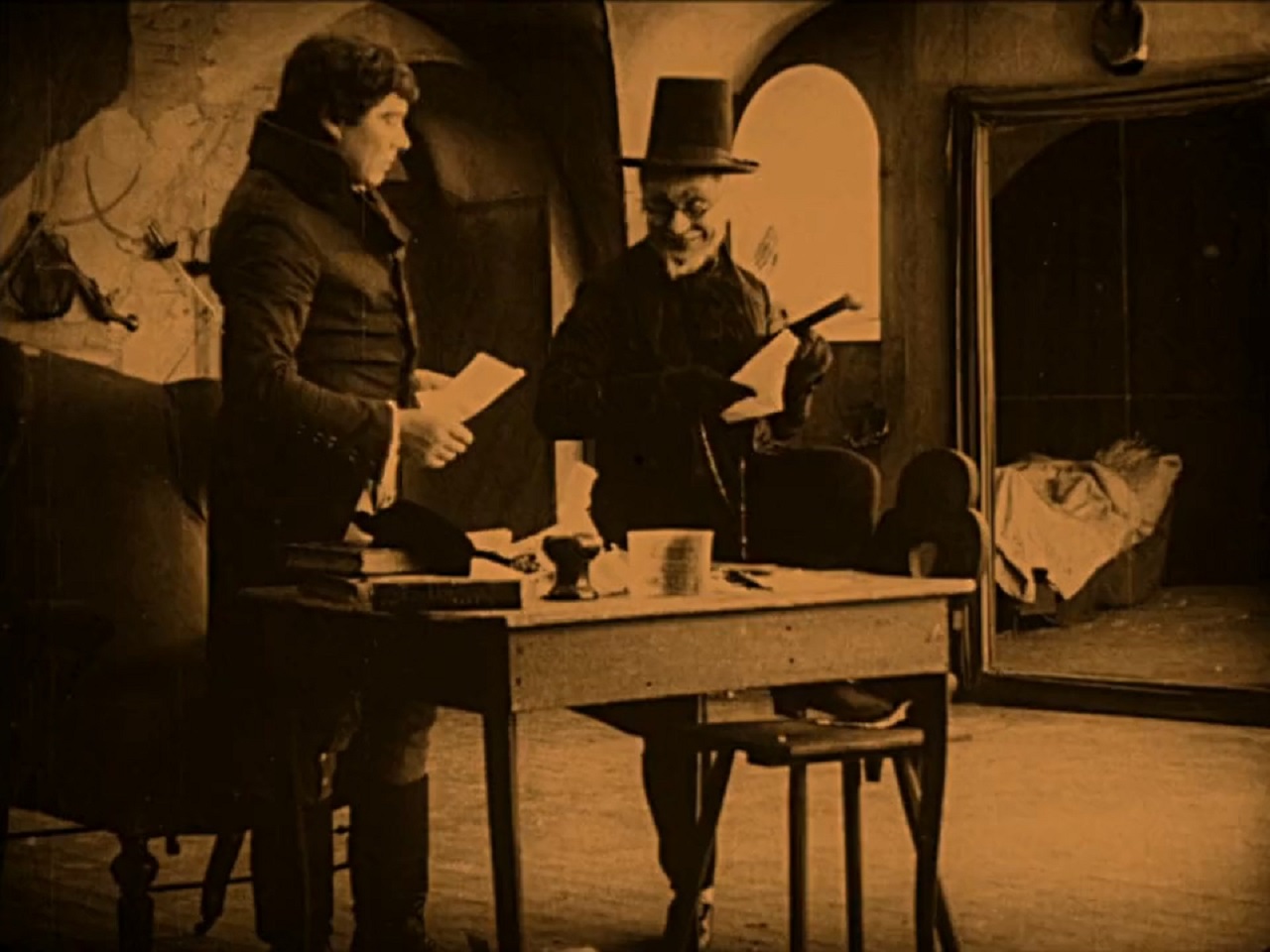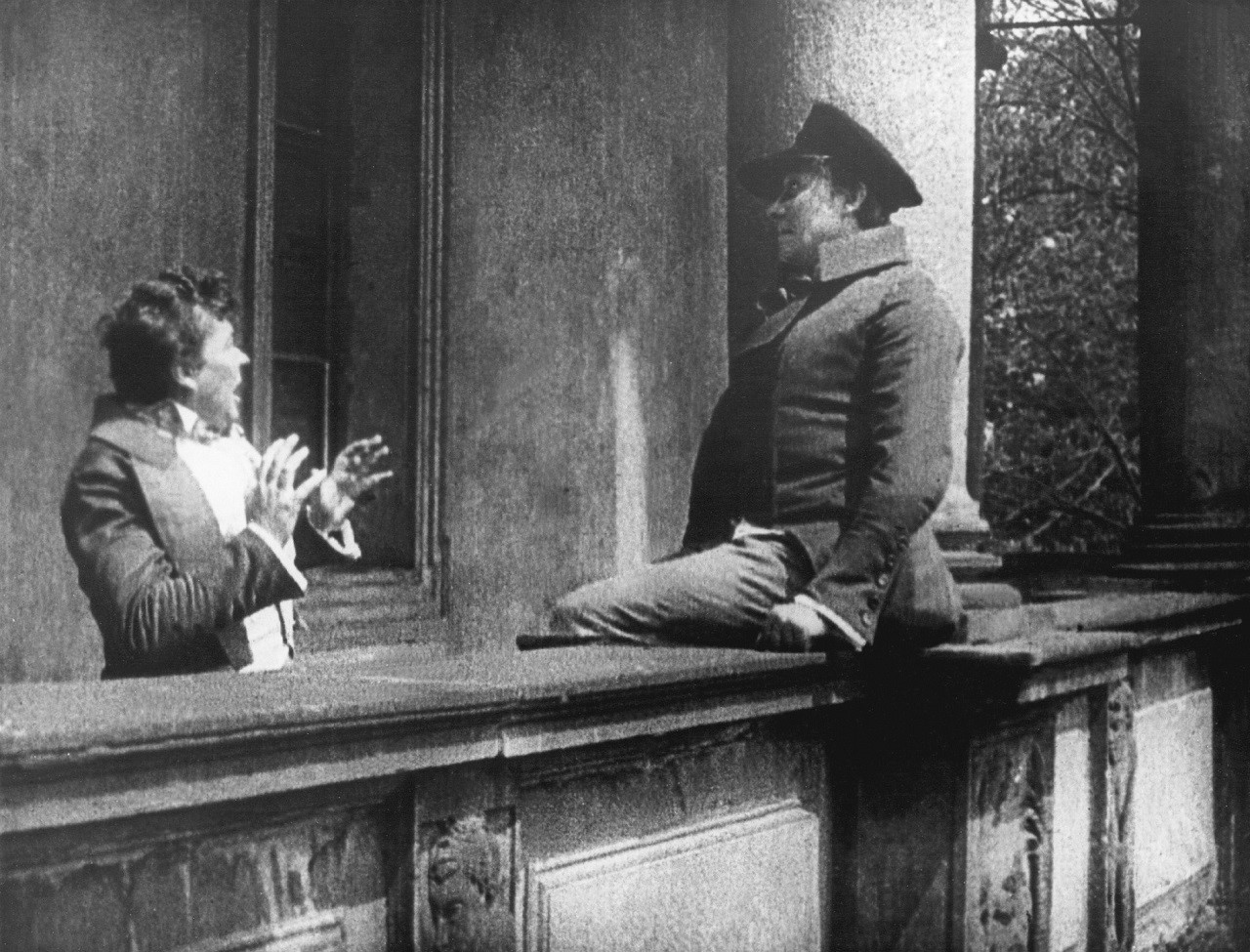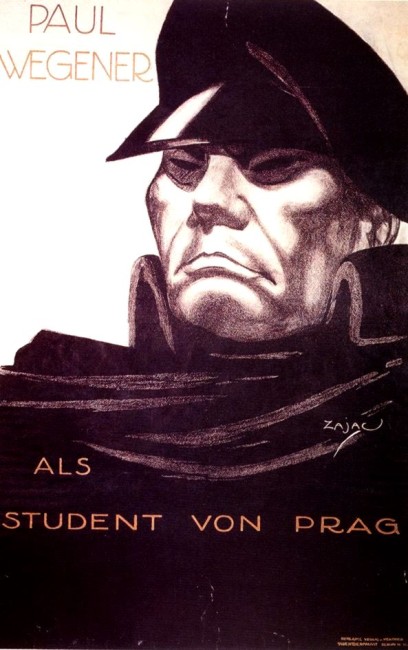(Der Student von Prag)
Germany. 1913.
Crew
Directors – Stellan Rye & Paul Wegener, Screenplay – Hans Heinz Ewers, Producer – Paul Wegener, Photography (b&w) – Guido Seeber, Production Design – Robert A. Dietrich & Klaus Ricther. Production Company – Bioscop-Film.
Cast
Paul Wegener (Balduin), Grete Berger (Countess Margit von Schwartzenberg), John Gottowt (Scapinelli), L. [Lyda] Salmanova (Lyduschka), Lothar Korner (Count von Schwartzenberg), Fritz Wiedemann (Baron Waldis-Schwartzenberg)
Plot
Prague, 1820. The university student Balduin is an expert swordsman but is penniless. He is approached by the aging Scapinelli who offers Balduin 100,000 gold coins in return for one small thing in his room. Balduin eagerly agrees only for the thing that Scapinelli chooses to be his shadow. With his newfound wealth, Balduin pursues Countess Margit von Schwartzenberg. However, the shadow appears, frightening her away. After finding Balduin’s letters to Margit, her fiance Baron Waldis-Schwartzenberg challenges Balduin to a duel. His father begs Balduin to spare the Baron only for the shadow to step in and kill the man.
The Student of Prague was one of the classics of the great era of silent German cinema. It was one of the formative works that began the whole cycle – more a prototypic work than an actual example of the genre, which would not be solidified until the hit of The Cabinet of Dr Caligari (1919) a few years later. It however brought together many of the key talents of the era. (For a more detailed overview see German Expressionism).
The film brought to attention stage actor Paul Wegener (1874-1948), previously a member of Max Reinhardt’s performing troupe. The Student of Prague was Wegener’s screen debut and he went on to appear in a number of key works of the era. The following year, Wegener appeared in/co-directed the classic, now lost version of The Golem (1914) and its surviving sequel The Golem (1920). Wegener made several other ventures into genre material during this era, acting/directing in The Yogi (1916), The Golem and the Dancing Girl (1917) and The Pied Piper of Hamlin (1918), as well as acting roles only in The Magician (1927), The Strange Case of Captain Rampar (1927), Svengali (1927) and Alraune (1928), among others. Wegener also appeared here for the first time with Polish actress Lyda Salmanova, whom he married around the same time (it is not clear whether they met on the set or before), then divorced in 1924 and remarried several years later.
Wegener’s co-director was the Danish-born Stellan Rye who had relocated in Germany after being jailed in Denmark for being gay. The Student of Prague was Rye’s first film. Rye went on to make made fifteen other films, most of which appear to now be lost. Rye then enlisted as a soldier with the German army with the outbreak of World War I only to end up being killed several months into the war in November of 1914. His entire film career had occurred within the space of just over a year.

Wegener was responsible for bringing on board German novelist and poet Hans Heinz Ewers (1871-1943). Ewers had just had success with his horror novel Alraune (1911) about a woman born artificially who has no soul. This became of great fascination and underwent a string of adaptations mostly during the silent era with the Hungarian Alraune (1918), the German Alraune (1918), Alraune (1928) starring Paul Wegener and the sound version Alraune/Daughter of Evil (1930). Ewers and Stellan Rye collaborated on several other films with The Seduced (1913), The Eisbraut (1913), … For All Guilt Takes Revenge on Earth (1913), The Eyes of Ole Brandis (1913), Evinrude (2014) and A Midsummer Night’s Dream in Our Time (1914), about which little is known due to the films being lost.
With The Student of Prague, Hans Heinz Ewers makes a Doppelganger film. He borrows the idea from the Edgar Allan Poe short story William Wilson (1839) in which a man is tormented by a double that reprimands him for his sins, although here Ewers turns the idea on its head and has the double be the one who conducts mischief. Ewers also draws much from the idea of the Diabolical Pact that appeared in the various versions of the Faust story in German literature where a man sells his soul to The Devil to win the love of a woman. Scapinelli appears to be more of a sorcerer than The Devil but the essential nature of the diabolical pact – selling a part of oneself only to have the agreement twisted around on them – remains.
For many years, this version of The Student of Prague was considered a lost film until a painstaking restoration for the film’s hundredth anniversary in 2013. I had seen and written up the remake The Student of Prague (1926) before getting around to watching the earlier version. Certainly, the 1926 version feels like a much more polished version of the story. Crucially, the 1913 version was made before the German Expressionist cycle found its feet, which it would not do so until after World War I with The Cabinet of Dr Caligari. After that point, German cinema began to adopt a highly stylised look – extravagant, distorted sets became the in thing and directors made much out of lighting using exaggerated shadows. The 1926 version is made in a full flight of German Expressionism; by contrast, the 1913 version is made before that was a glimmer in anybody’s eye and is a relatively more mundane affair.

I also feel that the 1926 version tells the story in a much more vivid way. Wegener and Rye lack a sense of dramatically staging the pageantry of the period setting, while the costuming comes out as rather frumpy. This never quite dramatically finds the heart of the story. It could well be that cinema at that time had not refined the process of editing and staging shots to make a story far more dramatic – the film never does much to dramatically build up the doppelganger’s appearances or even in showing what it does, for instance.
The major novelty the film had was that it is supposed to be the first time on screen that someone had used optical effects to allow an actor to interact with himself. (Although I have the suspicion that George Melies appeared alongside himself in a number of his short films – The India Rubber Head (1901) in particular comes to mind). There is one vivid scene where Wegener is at a gambling table and is then joined by the doppelganger who challenges him to take him on. The other of course is the classic ending where Wegener stabs the double only to then fall, discovering he has actually stabbed himself.
The story has been further remade as The Student of Prague (1935), a German sound-era production, and The Student of Prague (1990), a Czech-made tv mini-series.
Trailer here
Full film available here


